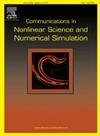具有不连续项的Chaplygin Euler方程的Riemann解:delta激波的消失和产生
IF 3.8
2区 数学
Q1 MATHEMATICS, APPLIED
Communications in Nonlinear Science and Numerical Simulation
Pub Date : 2025-07-28
DOI:10.1016/j.cnsns.2025.109170
引用次数: 0
摘要
本文详细地研究了两种不同的不连续源项下含Chaplygin气体的Euler方程的Riemann问题。通过接触不连续或三角洲激波以完全显式形式构造了四种黎曼解。与以往的连续源项研究不同,本文发现了一些有趣的非线性现象。例如,delta激波在有限时间内完全消失并分裂为两个接触不连续面。本文章由计算机程序翻译,如有差异,请以英文原文为准。
The Riemann solutions of the Chaplygin Euler equations with discontinuity terms: The disappearance and generation of a delta shock wave
In this paper, the Riemann problems for Euler equations with the Chaplygin gas under two different discontinuity source terms are considered in detail. Four kinds of Riemann solutions are constructed in fully explicit forms by the contact discontinuity or the delta shock wave. Different from previous studies with continuous source terms, some interesting nonlinear phenomena are found. For instance, the delta shock wave disappears completely and splits into two contact discontinuities in finite time.
求助全文
通过发布文献求助,成功后即可免费获取论文全文。
去求助
来源期刊

Communications in Nonlinear Science and Numerical Simulation
MATHEMATICS, APPLIED-MATHEMATICS, INTERDISCIPLINARY APPLICATIONS
CiteScore
6.80
自引率
7.70%
发文量
378
审稿时长
78 days
期刊介绍:
The journal publishes original research findings on experimental observation, mathematical modeling, theoretical analysis and numerical simulation, for more accurate description, better prediction or novel application, of nonlinear phenomena in science and engineering. It offers a venue for researchers to make rapid exchange of ideas and techniques in nonlinear science and complexity.
The submission of manuscripts with cross-disciplinary approaches in nonlinear science and complexity is particularly encouraged.
Topics of interest:
Nonlinear differential or delay equations, Lie group analysis and asymptotic methods, Discontinuous systems, Fractals, Fractional calculus and dynamics, Nonlinear effects in quantum mechanics, Nonlinear stochastic processes, Experimental nonlinear science, Time-series and signal analysis, Computational methods and simulations in nonlinear science and engineering, Control of dynamical systems, Synchronization, Lyapunov analysis, High-dimensional chaos and turbulence, Chaos in Hamiltonian systems, Integrable systems and solitons, Collective behavior in many-body systems, Biological physics and networks, Nonlinear mechanical systems, Complex systems and complexity.
No length limitation for contributions is set, but only concisely written manuscripts are published. Brief papers are published on the basis of Rapid Communications. Discussions of previously published papers are welcome.
 求助内容:
求助内容: 应助结果提醒方式:
应助结果提醒方式:


